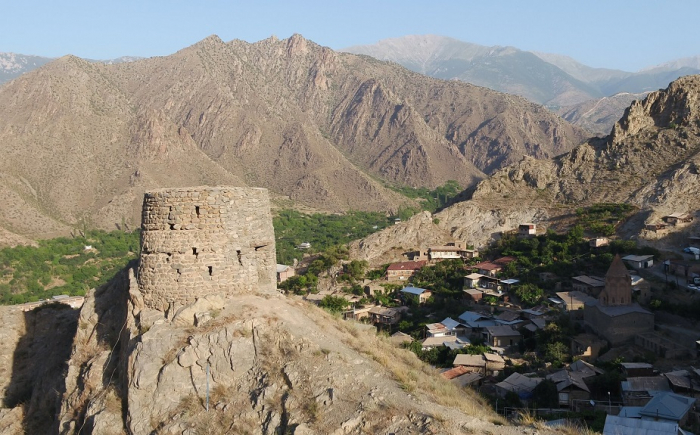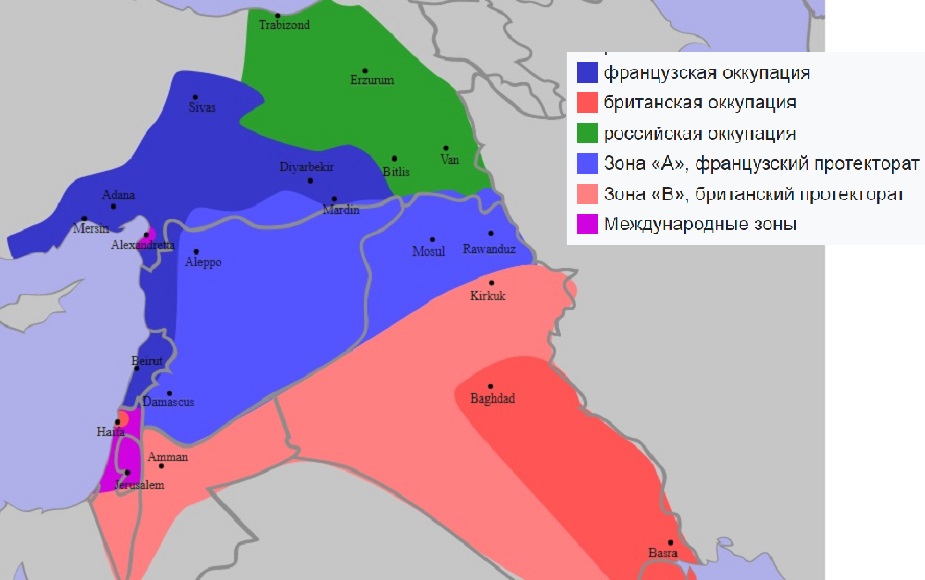ANALYTICS
04.06.21 12:20

Most political analysts began to take an interest in Zangezur only after the Second Karabakh War, when a peace agreement was signed, according to which a transport corridor between the main territory of Azerbaijan and the Nakhichevan Autonomous Republic should be organized through Zangezur. However, the very configuration of the borders in the Zangezur region suggests that it's current belonging to the Republic of Armenia was not organized accidentally at one time and has a long history. Moreover, the Zangezur corridor itself or the “Zangezur cutting strip” (depending on whose interests it is directed against) was “planned” a long time ago.
Let's start with the fact that Zangezur is primordially Azerbaijani land and it certainly was until the beginning of the 20th century. Even after the mass settlement of Armenian settlers from Iran and Turkey in Zangezur, the 1897 census showed the absolute majority of Azerbaijanis in the population of the Zangezur district.
However, with the beginning of the tragic events of the so-called. Revolution of 1905, in which the Armenian nationalists Dashnaks actively participated, the ethnic composition of the population in Zangezur began to forcibly change.
Dashnak gangs nowhere during the "revolutionary" terror of 1905-1907. did not act with such bestial cruelty as in Zangezur. Entire Azerbaijani villages were mercilessly destroyed by Dashnak thugs. The impression was that it was here that some influential forces wanted to carry out a deliberate ethnic cleansing of the Muslim population. Why - you could guess too.
Zangezur as a whole was a mountainous area, a "natural fortress", where the mountains came close to the border of the Russian Empire and the Qajar state along the Araks River. In the very same Qajar state in the same 1905, the anti-Kajar so-called. "Revolution", in which the influence of Great Britain was noticeable even with the naked eye.
Considering that by that time Baku was becoming the main "oil" industrial center of Russia, and the Armenian capital absolutely dominated in the key cities of the South Caucasus, including Tiflis (Tbilisi), the plans of the destructive forces were easily miscalculated. An "arc" or "strip" was created from the Araks to Tiflis, under the control of the Armenian nationalists, conducted from outside, which cut the Caucasus and "cut off" Baku from the Black Sea.
Moreover, Zangezur was apparently the key in organizing this "strip" - there were no large cities that could become "outposts" of Armenian nationalists, and the indigenous Azerbaijani population was undoubtedly loyal to the Empire. Therefore, first of all, it was in Zangezur that the lands were “cleared” of the native Azerbaijani population by bloody methods, so that, if the opportunity arises, the Armenian extremists acting in the interests of the Western powers hostile to Russia could have direct communication with them across the border along the Araks River.
Furthermore. Great Britain and France managed to drag Russia into the First World War, "seducing" it with the illusory prospect of control over the Black Sea straits and "territorial growth" of possessions in Asia. But it is enough to look at the map of the division of spheres of influence under the Sykes-Picot agreement, and it is immediately striking that the “stripes and corridors” in the South Caucasus simply “perfectly fit” the directions of expansion of some Western powers.

Recall that the secret Sykes-Pico agreement was signed on May 16, 1916. This agreement between the governments of Great Britain, France, the Russian Empire, and Italy, which later joined it, delimited the spheres of interest in the Middle East for the period after the First World War. At the same time, it is enough to look at the map to see: France and Great Britain created a “double barrier” from their “future possessions” on the path of Russia's possible expansion towards the Mediterranean Sea.
Here, the answer to the question is simply given, would the fiery allies give Russia the Bosphorus and Dardanelles straits? Of course not! Otherwise, the British would never have agreed to cede oil-rich Mosul to the French.
Since Britain was interested in the conflict between Russia and France and in France's restraining the expansion of Russia, they "shared" in advance with the French the most "tasty" pieces of the territory of the "not yet killed" Ottoman Empire. If only the French would “stand up as a wall” in the way of the advancement of the Russians in the direction of the Mediterranean Sea and destabilize the situation in the Russian Empire itself with the help of their agents' Armenian nationalists.
According to the Sykes-Picot agreement, France was not only assigned a "strip" from Syria to the border with Iran with access to this border east of Mosul but also almost directly implied "continuation of the strip". Considering that Iran, also figuratively speaking, was “subject to division”, it is possible that this strip would be “extended” to that very Zangezur, where the “friends” of the French, the Armenian Dashnaks, “cleared” the land from the native Azerbaijani population.
In this regard, the visit of Prime Minister Nikol Pashinyan to France and his frank "inviting" French troops to Zangezur cannot but inspire concern. As we can see, the French wanted to penetrate the region for a long time. And that Zangezur among the "targets" was outlined more than 105 years ago.
From this, it becomes clear why the Dashnaks, even suffering a crushing defeat in the war with Turkey in 1920, surrendering Alesandropol (Gyumri) to the Turks, still transferred all their most combat-ready groups of thugs to Zangezur. After all, Zangezur was extremely important for the Armenian nationalist project and for those who "conducted" it from the Western capitals.
However, the situation in the world has radically changed since those times. France is no longer the huge colonial empire that it was after the First World War. The "world economic landscape" has also changed, the role of Asia and, in particular, China, as well as the ways of communication across the Eurasian continent, has increased in the world economy. And now communications between East Asia and Europe require the demolition of all the old artificial dividing lines. Therefore, in fact, the Zangezur corridor will mean the beginning of a new era and the end of the old geopolitical "games" that have brought so much grief and suffering to the peoples.
KavkazPlus
Read: 343
Write comment
(In their comments, readers should avoid expressing religious, racial and national discrimination, not use offensive and derogatory expressions, as well as appeals that are contrary to the law)
News feed
-
Tusheti Protected Landscape in Georgia’s north-east to expand by 2,245 hectares
18:0023.04.24
-
17:2823.04.24
-
16:5623.04.24
-
16:2023.04.24
-
15:4423.04.24
-
15:0623.04.24
-
Georgian PM, UN representatives review cooperation
14:3523.04.24
-
14:0023.04.24
-
Four people were arrested for making and issuing fake driving licenses
13:2023.04.24
-
12:3923.04.24
-
Georgian, Croatian foreign ministers discuss “fruitful” cooperation
11:3023.04.24
-
Georgian foreign office welcomes border delimitation deal between Armenia, Azerbaijan
10:4523.04.24
-
10:0023.04.24
-
8:0023.04.24
-
18:0022.04.24
-
Prosecutor's Office arrests organized criminal group members involved in call centres
17:2722.04.24
-
Economy Minister: Georgian economy to become “one of fastest-growing” in Europe, wider region
16:5522.04.24
-
Deputy Economy Minister: over million travellers, “record-high” EU visitors entered Georgia in Q1
16:3122.04.24
-
Girchi Party sceptical about their Political Lobbying bill's support in Parliament
16:0022.04.24
-
Russian occupation forces illegally arrest two citizens of Georgia near village of Dirbi
15:3022.04.24
-
14:5722.04.24
-
Shalva Papuashvili: The age permitted for marriage - 18 years - will be written in the Constitution
14:1622.04.24
-
13:1022.04.24
-
Environmental Ministry tightens restrictions on Boxtree cutting
12:3422.04.24
-
12:0522.04.24
-
11:3122.04.24
-
10:0022.04.24
-
18:0019.04.24
-
The state property the government sold this year at the lowest price
17:3019.04.24
-
17:0019.04.24
-
16:1919.04.24
-
Vakhtang Gomelauri: An attack on a policeman means an attack on a state institution
15:4119.04.24
-
15:0019.04.24
-
14:1519.04.24
-
What are the dangers of France's interference in Ukraine and the South Caucasus?
13:3719.04.24
-
The Prime Minister met the Ambassador of Iran in Georgia
12:5719.04.24


